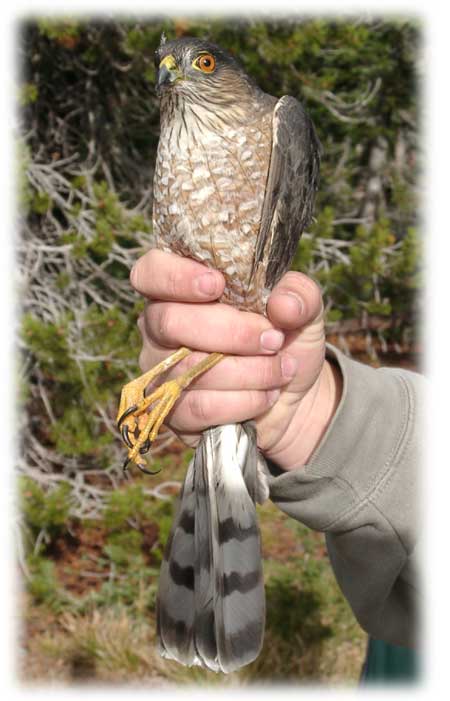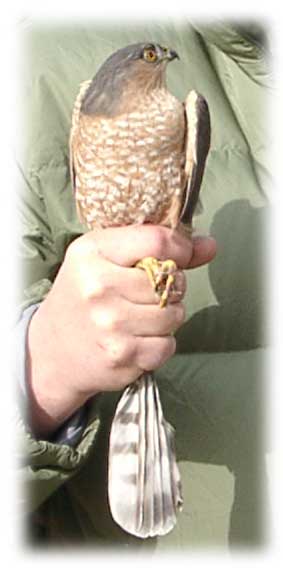This bird is native to North America. It is not a traditional bird in falconry as it does not exist in the wild in Europe, but it has been used for falconry. The Sharp-Shinned Hawk is named for the thin ridge which runs along the bird's long legs, or tarsus, giving the appearance of a "sharp shin".
The female will have a flying weight from, roughly, 150g to 220g. These birds take a significant amount of attention to manage and fly. Males are often favored by falconers as they are thought to carry starlings much less than females, however males are difficult to keep in top condition and fly well at the same time. Being small, they are often hunted by wild animals when out hunting, and can quickly succumb to disease.
 |
 |
Two mature Sharp-Shin Hawks just trapped for banding.
Note the safe way to restrain this small bird. |
The immature Sharpie is a creamy white with small brown splotches looking like they have been dotted with a paint brush down their chest. The wings have parallel stripes running the length of them - all in a tan and brown coloring which blends with the landscape they live in. The immature bird has yellow eyes which will turn orange and then red through the years.
The adult Sharpie has reddish-brown bars across the chest and a dark head extending down the nape of the neck. The tail has several wide bands across it. The back, wings, and tail are a blue-gray. As an adult it will develop red eyes.
Morphology
The body form of the Sharp-Shin is marked by a long tail that is square at the end. The tail acts as a rudder to steer the bird during their quick forward flight and acceleration. Contrast that with the soaring Red-Tail, the Accipiters in general need a longer tail for their flight style.
The Sharp-Shin and the Cooper's hawk are sometimes confused. If looking at the two in profile, the Cooper's will be slightly larger and have the appearance of a more flat head and a more pronounced brow. The Sharp-Shin will have a more rounded head and a less pronounced brow. The Sharp-Shin also has a more square tail while the Cooper's appears much more rounded. As an adult, both will develop red eyes.
This hawk displays the most pronounced sexual dimorphism of any of the hawks with the female being considerably larger than the male. The male will be the size of a typical Robin.
If using a neck bell on this bird, the neck bell tie should be the diameter of a dime.
Hunting
Typical quarry caught with the Sharpie will be small birds such a sparrows and starlings but will also take quail, doves, and even a young chicken. In the wild they catch finches and various songbirds, as well and can be seen darting in and out of thickets after these birds. It will dart through thick trees to the edge of a field and grab small birds there, but is also highly effective in an urban setting. Any kind of tight spot with close range hunts are ideal for a Sharp-shin Hawk. This bird can be hunted almost anywhere as there is plenty of quarry for it. Most all the hunting is up close so the falconer really gets to see the flights. In the wild these birds almost exclusively feed on small birds, which demands a diet in captivity of small birds. It does best with regular meals of English sparrows.
Trivia
The Sharp-shin is commonly referred to as the Sharpie although also called a sparrow hawk.
The Sharp-shin makes a relatively large nest about 30' - 40' high in a pine or spruce tree.
This is one of the most migratory birds and can be difficult to hunt at times.
Prefers woodlands and thickets that attract the small birds they like to hunt. Their diet primarily consists of birds.
The male Sharp-Shin will fly at about 100g while the female Sharp-Shin will fly at around 170g.
For its size, this bird has the largest foot of any of the birds used in falconry. It uses these long toes to grab around its prey and puncture the vitals.
The Sharpie is one of the birds more prone to apoplexy, and has a high metabolism. It is a delicate, high-strung bird that is difficult to manage and seems to be prone to injuries. Because of this, and the fact that the bird tends to naturally hunt non-game birds, this can be a difficult bird to hunt.
Links
http://www.desertusa.com/birds/sharp-shinned-hawk.html
http://www.nenature.com/SharpShinnedHawk.htm
https://www.mbr-pwrc.usgs.gov/id/framlst/i3320id.html